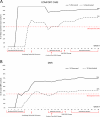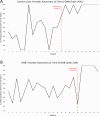Improving implantable cardioverter defibrillator deactivation discussions in admitted patients made DNR and comfort care
- PMID: 31922034
- PMCID: PMC6937107
- DOI: 10.1136/bmjoq-2019-000730
Improving implantable cardioverter defibrillator deactivation discussions in admitted patients made DNR and comfort care
Abstract
Background: Unintended shocks from implantable cardioverter defibrillators (ICDs) are often distressing to patients and family members, particularly at the end of life. Unfortunately, a large proportion of ICDs remain active at the time of death among do not resuscitate (DNR) and comfort care patients.
Methods: We designed standardised teaching sessions for providers and implemented a novel decision tool in the electronic medical record (EMR) to improve the frequency of discussions surrounding ICD deactivation over a 6-month period. The intended population was patients on inpatient medicine and cardiology services made DNR and/or comfort care. These rates were compared with retrospective data from 6 months prior to our interventions.
Results: After our interventions, the rates of discussions regarding deactivation of ICDs improved from 50% to 93% in comfort care patients and from 32% to 70% in DNR patients. The rates of deactivated ICDs improved from 45% to 73% in comfort care patients and from 29% to 40% in DNR patients.
Conclusion: Standardised education of healthcare providers and decision support tools and reminders in the EMR system are effective ways to increase awareness, discussion and deactivation of ICDs in comfort care and DNR patients.
Keywords: patient preference; patient-centred care; quality improvement; standards of care.
© Author(s) (or their employer(s)) 2019. Re-use permitted under CC BY-NC. No commercial re-use. See rights and permissions. Published by BMJ.
Conflict of interest statement
Competing interests: None declared.
Figures


Similar articles
-
Deactivation of Implantable Cardioverter Defibrillator in Patients With Terminal Diagnoses.Am J Cardiol. 2019 Oct 1;124(7):1064-1068. doi: 10.1016/j.amjcard.2019.07.007. Epub 2019 Jul 15. Am J Cardiol. 2019. PMID: 31353003
-
Defibrillator patients should not be denied a peaceful death.Int J Cardiol. 2015 Mar 1;182:440-6. doi: 10.1016/j.ijcard.2015.01.012. Epub 2015 Jan 6. Int J Cardiol. 2015. PMID: 25597981
-
Trends in time in the management of the implantable cardioverter defibrillator in the last phase of life: a retrospective study of medical records.Eur J Cardiovasc Nurs. 2019 Aug;18(6):449-457. doi: 10.1177/1474515119844660. Epub 2019 Apr 17. Eur J Cardiovasc Nurs. 2019. PMID: 30995145 Free PMC article.
-
[Implantable automatic defibrillators and their deactivation, a necessary conversation. Literature review].Rev Med Chil. 2023 Oct;151(10):1399-1405. doi: 10.4067/s0034-98872023001001399. Rev Med Chil. 2023. PMID: 39093143 Review. Spanish.
-
Deactivation of Implantable Cardioverter-Defibrillators in Heart Failure: A Systematic Review.J Hosp Palliat Nurs. 2018 Feb;20(1):63-71. doi: 10.1097/NJH.0000000000000399. J Hosp Palliat Nurs. 2018. PMID: 30063615
Cited by
-
Using clinical decision support tools to increase defibrillator deactivations in dying patients.BMJ Open Qual. 2022 Aug;11(3):e001729. doi: 10.1136/bmjoq-2021-001729. BMJ Open Qual. 2022. PMID: 35926983 Free PMC article. No abstract available.
-
The difficult discussion on the deactivation of implantable cardioverter devices at the end of life: a systematic review.ESC Heart Fail. 2025 Apr;12(2):733-760. doi: 10.1002/ehf2.14831. Epub 2024 May 13. ESC Heart Fail. 2025. PMID: 38741255 Free PMC article.
-
Ten Questions and Some Reflections about Palliative Care in Advanced Heart Failure Patients.J Clin Med. 2022 Nov 24;11(23):6933. doi: 10.3390/jcm11236933. J Clin Med. 2022. PMID: 36498508 Free PMC article. Review.
-
Shared Decision-Making Tools Implemented in the Electronic Health Record: Scoping Review.J Med Internet Res. 2025 Feb 21;27:e59956. doi: 10.2196/59956. J Med Internet Res. 2025. PMID: 39983125 Free PMC article.
-
Characteristics of Clinicians Are Associated With Their Beliefs About ICD Deactivation: Insight From the DECIDE-HF Study.CJC Open. 2021 Aug 8;3(8):994-1001. doi: 10.1016/j.cjco.2021.03.006. eCollection 2021 Aug. CJC Open. 2021. PMID: 34505038 Free PMC article.
References
MeSH terms
LinkOut - more resources
Full Text Sources
Medical
